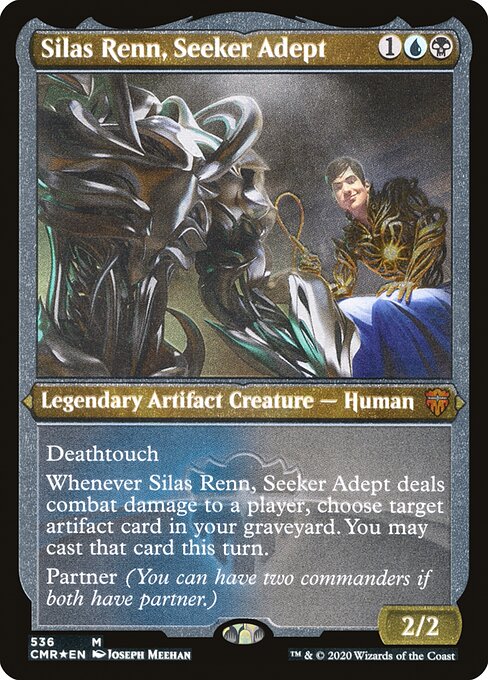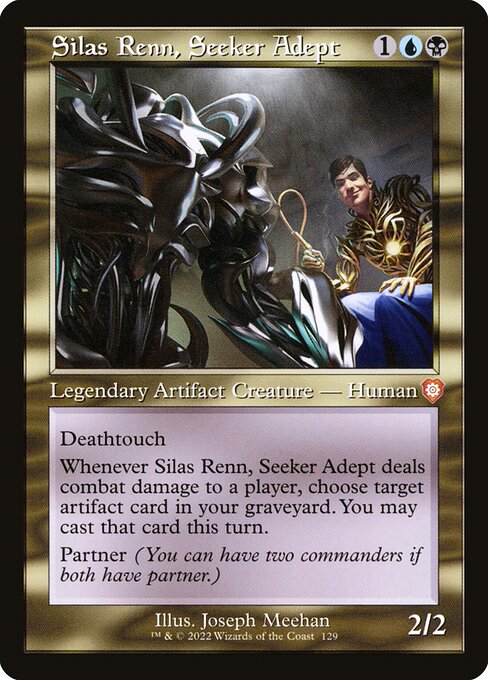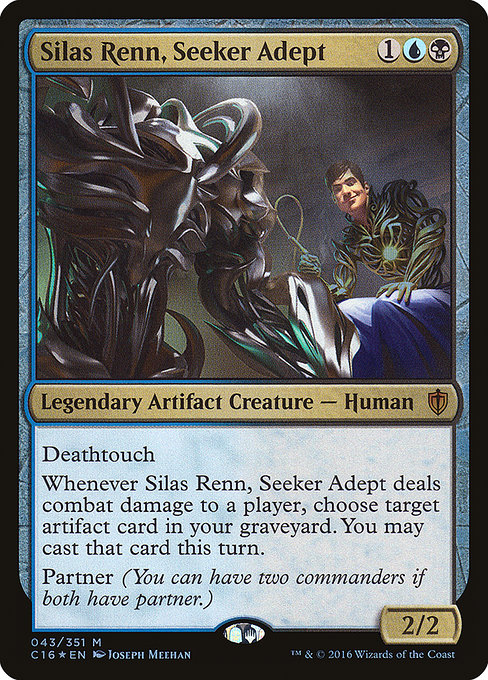standard
future
historic
gladiator
pioneer
explorer
modern
legacy
pauper
vintage
penny
commander
brawl
alchemy
paupercommander
duel
oldschool
premodern
Rulings
To have two commanders, both must have the partner ability as the game begins. Losing the ability during the game doesn’t cause either to cease to be your commander.
If you don’t cast the card, it remains in your graveyard.
Silas Renn doesn’t change when you can cast the target artifact card. For example, if you target an artifact card without flash, you can cast it only during your main phase when the stack is empty.
If something refers to your commander while you have two commanders, it refers to one of them of your choice. If you are instructed to perform an action on your commander (e.g. put it from the command zone into your hand due to Command Beacon), you choose one of your commanders at the time the effect happens.
An effect that instructs you to “cast” a card doesn’t allow you to play lands.
Casting the card causes it to leave your graveyard and become a new object. You can’t cast it multiple times.
You pay the costs for the target artifact card if you cast it. You may pay alternative costs rather than the card’s mana cost.
If your Commander deck has two commanders, you can only include cards whose own color identities are also found in your commanders’ combined color identities. If Falthis and Kediss are your commanders, your deck may contain cards with black and/or red in their color identity, but not cards with green, white, or blue.
You may cast that card this turn even if Silas Renn leaves the battlefield.
Both commanders start in the command zone, and the remaining 98 cards (or 58 cards in a Commander Draft game) of your deck are shuffled to become your library.
Once the game begins, your two commanders are tracked separately. If you cast one, you won’t have to pay an additional the first time you cast the other. A player loses the game after having been dealt 21 damage from any one of them, not from both of them combined.
You can choose two commanders with partner that are the same color or colors. In Commander Draft, you can even choose two of the same commander with partner if you drafted them. If you do this, make sure you keep the number of times you’ve cast each from the command zone clear for “commander tax” purposes.
An effect that checks whether you control your commander is satisfied if you control one or both of your two commanders.
If you don’t cast the card, it remains in your graveyard.
Silas Renn doesn’t change when you can cast the target artifact card. For example, if you target an artifact card without flash, you can cast it only during your main phase when the stack is empty.
If something refers to your commander while you have two commanders, it refers to one of them of your choice. If you are instructed to perform an action on your commander (e.g. put it from the command zone into your hand due to Command Beacon), you choose one of your commanders at the time the effect happens.
An effect that instructs you to “cast” a card doesn’t allow you to play lands.
Casting the card causes it to leave your graveyard and become a new object. You can’t cast it multiple times.
You pay the costs for the target artifact card if you cast it. You may pay alternative costs rather than the card’s mana cost.
If your Commander deck has two commanders, you can only include cards whose own color identities are also found in your commanders’ combined color identities. If Falthis and Kediss are your commanders, your deck may contain cards with black and/or red in their color identity, but not cards with green, white, or blue.
You may cast that card this turn even if Silas Renn leaves the battlefield.
Both commanders start in the command zone, and the remaining 98 cards (or 58 cards in a Commander Draft game) of your deck are shuffled to become your library.
Once the game begins, your two commanders are tracked separately. If you cast one, you won’t have to pay an additional the first time you cast the other. A player loses the game after having been dealt 21 damage from any one of them, not from both of them combined.
You can choose two commanders with partner that are the same color or colors. In Commander Draft, you can even choose two of the same commander with partner if you drafted them. If you do this, make sure you keep the number of times you’ve cast each from the command zone clear for “commander tax” purposes.
An effect that checks whether you control your commander is satisfied if you control one or both of your two commanders.
Rulings
To have two commanders, both must have the partner ability as the game begins. Losing the ability during the game doesn’t cause either to cease to be your commander.
If you don’t cast the card, it remains in your graveyard.
Silas Renn doesn’t change when you can cast the target artifact card. For example, if you target an artifact card without flash, you can cast it only during your main phase when the stack is empty.
If something refers to your commander while you have two commanders, it refers to one of them of your choice. If you are instructed to perform an action on your commander (e.g. put it from the command zone into your hand due to Command Beacon), you choose one of your commanders at the time the effect happens.
An effect that instructs you to “cast” a card doesn’t allow you to play lands.
Casting the card causes it to leave your graveyard and become a new object. You can’t cast it multiple times.
You pay the costs for the target artifact card if you cast it. You may pay alternative costs rather than the card’s mana cost.
If your Commander deck has two commanders, you can only include cards whose own color identities are also found in your commanders’ combined color identities. If Falthis and Kediss are your commanders, your deck may contain cards with black and/or red in their color identity, but not cards with green, white, or blue.
You may cast that card this turn even if Silas Renn leaves the battlefield.
Both commanders start in the command zone, and the remaining 98 cards (or 58 cards in a Commander Draft game) of your deck are shuffled to become your library.
Once the game begins, your two commanders are tracked separately. If you cast one, you won’t have to pay an additional the first time you cast the other. A player loses the game after having been dealt 21 damage from any one of them, not from both of them combined.
You can choose two commanders with partner that are the same color or colors. In Commander Draft, you can even choose two of the same commander with partner if you drafted them. If you do this, make sure you keep the number of times you’ve cast each from the command zone clear for “commander tax” purposes.
An effect that checks whether you control your commander is satisfied if you control one or both of your two commanders.
If you don’t cast the card, it remains in your graveyard.
Silas Renn doesn’t change when you can cast the target artifact card. For example, if you target an artifact card without flash, you can cast it only during your main phase when the stack is empty.
If something refers to your commander while you have two commanders, it refers to one of them of your choice. If you are instructed to perform an action on your commander (e.g. put it from the command zone into your hand due to Command Beacon), you choose one of your commanders at the time the effect happens.
An effect that instructs you to “cast” a card doesn’t allow you to play lands.
Casting the card causes it to leave your graveyard and become a new object. You can’t cast it multiple times.
You pay the costs for the target artifact card if you cast it. You may pay alternative costs rather than the card’s mana cost.
If your Commander deck has two commanders, you can only include cards whose own color identities are also found in your commanders’ combined color identities. If Falthis and Kediss are your commanders, your deck may contain cards with black and/or red in their color identity, but not cards with green, white, or blue.
You may cast that card this turn even if Silas Renn leaves the battlefield.
Both commanders start in the command zone, and the remaining 98 cards (or 58 cards in a Commander Draft game) of your deck are shuffled to become your library.
Once the game begins, your two commanders are tracked separately. If you cast one, you won’t have to pay an additional the first time you cast the other. A player loses the game after having been dealt 21 damage from any one of them, not from both of them combined.
You can choose two commanders with partner that are the same color or colors. In Commander Draft, you can even choose two of the same commander with partner if you drafted them. If you do this, make sure you keep the number of times you’ve cast each from the command zone clear for “commander tax” purposes.
An effect that checks whether you control your commander is satisfied if you control one or both of your two commanders.
Your collection? Your decks?
Want to manage your collection and/or create decks?



 0
0
 0.39€
0.39€
